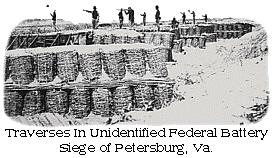 Traverses were raised mounds of earth designed
to defilade the interior spaces of field works and to limit the area effected
by explosions occurring within gun positions. For the most part traverses
were given a rectangular outline with the mound surfaces sloped upward and
inward from the base to form a rounded peak along the upper surface or crown.
Length and thickness primarily depended on the weight of shot or shell fragments
that the structure was designed to intercept. Traverses could be placed at
almost any point within the interior of a field work where they could intercept
enemy fire that might pass over the parapet and strike the work's defensive
surfaces. In most cases traverses were connected to and given a direction
perpendicular to the general direction of a field work's parapet; in some
cases traverses were positioned inside field works' sally ports to intercept
fire passing through the sally port and provide the garrison with a solid
base to defend the sally port barrier. When the interior of a work could
be seen from a nearby height a long traverse, called a parados, could be
constructed across the terre-parade to intercept reverse fire that might
strike the banquette or gun platforms of the parapet on the opposite side
of the work. Traverses could also be made to serve a number of secondary
purposes such as the covering masses of magazines or bomb-proof shelters
and as interior retrenchments to seal off advanced sections of a field work's
trace. Traverses were raised mounds of earth designed
to defilade the interior spaces of field works and to limit the area effected
by explosions occurring within gun positions. For the most part traverses
were given a rectangular outline with the mound surfaces sloped upward and
inward from the base to form a rounded peak along the upper surface or crown.
Length and thickness primarily depended on the weight of shot or shell fragments
that the structure was designed to intercept. Traverses could be placed at
almost any point within the interior of a field work where they could intercept
enemy fire that might pass over the parapet and strike the work's defensive
surfaces. In most cases traverses were connected to and given a direction
perpendicular to the general direction of a field work's parapet; in some
cases traverses were positioned inside field works' sally ports to intercept
fire passing through the sally port and provide the garrison with a solid
base to defend the sally port barrier. When the interior of a work could
be seen from a nearby height a long traverse, called a parados, could be
constructed across the terre-parade to intercept reverse fire that might
strike the banquette or gun platforms of the parapet on the opposite side
of the work. Traverses could also be made to serve a number of secondary
purposes such as the covering masses of magazines or bomb-proof shelters
and as interior retrenchments to seal off advanced sections of a field work's
trace.
Various types of traverses can be divided into four
main groups (defilade traverses, parados, sally port traverses, and battery
traverses) based on their general purposes and locations within field works.
1) Defilade Taverses include all traverses whose dimensions and position
were determined through the process of defilading and were primarily intended
to prevent the enemy from seeing and firing onto the defensive surfaces inside
a field work. In most cases defilade traverses were positioned near the interior
sides of parapets and
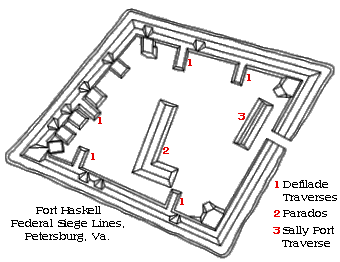 usually
had their longest sides of their bases perpendicular to the direction of
the parapet. This type of traverse could also be used as interior retrenchments
and as covering masses for magazines. Dimensions of defilade traverses, as
with the thickness of parapets, depended on the weight of shot and shell
that could be brought against the field work and the expected persistence
of the bombardment. Those made to intercept the fire of heavy siege and garrison
guns could be 12 to 18 feet thick, those designed to withstand prolonged
bombardments could be 24 to 40 feet thick. Traverses in rifle trenches would
only need to be 2 to 3 feet thick to intercept small arms fire. usually
had their longest sides of their bases perpendicular to the direction of
the parapet. This type of traverse could also be used as interior retrenchments
and as covering masses for magazines. Dimensions of defilade traverses, as
with the thickness of parapets, depended on the weight of shot and shell
that could be brought against the field work and the expected persistence
of the bombardment. Those made to intercept the fire of heavy siege and garrison
guns could be 12 to 18 feet thick, those designed to withstand prolonged
bombardments could be 24 to 40 feet thick. Traverses in rifle trenches would
only need to be 2 to 3 feet thick to intercept small arms fire.
2) Parados Traverses were also produced
through the process of defilading, but were positioned independent of the
parapet across the terre-parade of field works to intercept reverse fire
that might strike the terre-parade and banquette of the parapet opposite
to the direction from which the fire was delivered. A parados could also
serve as a bomb or splinter proof shelter; when it extended the full width
of the terre-parade it could be pierced with access galleries that allowed
movement between the divided the terre-parade.
3) Sally Port Traverses were generally placed
on the terre-parade immediately behind sally ports to both intercept enemy
fire that might pass through the sally port and provide the garrison a short
parapet to deliver fire into the sally port and defend the sally port barrier.
For the most part sally port traverses were given the same profile as a field
work's parapet; its length was determined by the width of the sally port.
Wider sally ports required longer sally port traverses to intercept fire
entering the sally port at an angle that might otherwise strike the work's
parapets in reverse. If enemy troops were able to break through the sally
port barrier and enter the work they would either be forced to turn their
flanks to the front of the sally port traverse and dash
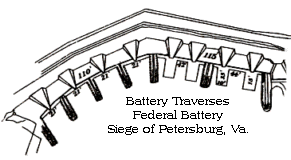 through a close enfilading fire to gain the terre-parade
or assault the traverse head-on. through a close enfilading fire to gain the terre-parade
or assault the traverse head-on.
4) Battery Traverses were placed in batteries
between guns to limit the havoc caused by enemy shells exploding within the
battery and to restrict the damage caused by accidental explosions or the
premature explosion of fired shells. This type of traverse was not usually
intended to intercept enemy fire and was therefore given a splinter-proof
thickness (6 to 8 feet) only capable of absorbing shell fragments. Length
was determined by the weight of guns or howitzers forming the battery's armament:
field guns required traverses 15 to 18 feet long, siege guns required traverses
18 to 24 feet long.
 Methods
for laying out and constructing traverses prescribed by pre-Civil War engineering
manuals generally seem to have been followed in temporary and hastily constructed
field works. But prescribed methods were inadequate for the construction
of very large traverses required in sea-coast defense field works such as
Fort Fisher, North Carolina and proved incapable of producing traverses that
could stand against the deterioration of revetment materials and erosive
effects of weather over prolonged periods in the various systems semi-permanent
field works that protected many important cities. D. H. Mahan's Treatise
on Field Fortification (1861) described a bomb-proof defilade traverse
called a gabionade that was approximately 12 feet wide and 24 feet
long at the base constructed from two courses of Methods
for laying out and constructing traverses prescribed by pre-Civil War engineering
manuals generally seem to have been followed in temporary and hastily constructed
field works. But prescribed methods were inadequate for the construction
of very large traverses required in sea-coast defense field works such as
Fort Fisher, North Carolina and proved incapable of producing traverses that
could stand against the deterioration of revetment materials and erosive
effects of weather over prolonged periods in the various systems semi-permanent
field works that protected many important cities. D. H. Mahan's Treatise
on Field Fortification (1861) described a bomb-proof defilade traverse
called a gabionade that was approximately 12 feet wide and 24 feet
long at the base constructed from two courses of
 gabions
interlocked by an intermediate course of fascines. Other manuals, such as
J. S. Macaulay's Treatise on Field Fortification, a British manual,
indicated that traverses could be revetted with fascines, planks, gabions,
or any other material capable of limiting the base required for a traverse
and retaining soil at a quite unnatual slope. gabions
interlocked by an intermediate course of fascines. Other manuals, such as
J. S. Macaulay's Treatise on Field Fortification, a British manual,
indicated that traverses could be revetted with fascines, planks, gabions,
or any other material capable of limiting the base required for a traverse
and retaining soil at a quite unnatual slope.
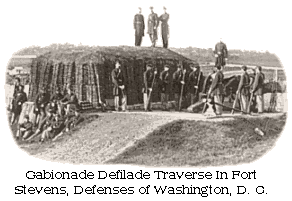 Most of the early field works
constructed in the defensive lines surrounding Washington, D. C. were constructed
according to Mahan's manual, but these proved a bit too temporary and many
were later replaced by unrevetted shaped mounds that were allowed to fall
at the natural angle of the soil. These were generally planted over with
grasses to resist erosion and seem to have been much more durable than revetted
traverses. These large unrevetted traverses required more interior space
than revetted traverses and could not be applied in situations where interior
space was limited. Even larger unrevetted traverses were constructed in some
Confederate sea-coast defense fortifications, these were generally constructed
from either piled sand topped by a good layer of coastal grasses that imparted
a rather rounded hap-hazard appearance to the Most of the early field works
constructed in the defensive lines surrounding Washington, D. C. were constructed
according to Mahan's manual, but these proved a bit too temporary and many
were later replaced by unrevetted shaped mounds that were allowed to fall
at the natural angle of the soil. These were generally planted over with
grasses to resist erosion and seem to have been much more durable than revetted
traverses. These large unrevetted traverses required more interior space
than revetted traverses and could not be applied in situations where interior
space was limited. Even larger unrevetted traverses were constructed in some
Confederate sea-coast defense fortifications, these were generally constructed
from either piled sand topped by a good layer of coastal grasses that imparted
a rather rounded hap-hazard appearance to the
 traverses' surfaces or well shaped sand and clay
combinations that could retain both a good slope and sharp angle between
adjoining surfaces. traverses' surfaces or well shaped sand and clay
combinations that could retain both a good slope and sharp angle between
adjoining surfaces.
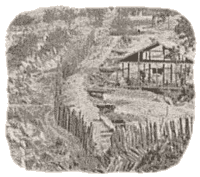 Traverses
were not limited to major field works, but were often necessay in hastily
constructed lines of rifle trenches. Confederate trenches at Arkansas Post,
for instance, were protected by some sort of wooden traverses that might
have been constructed as stockade work or as piled rails. Some photographs
of the Confederate lines protecting Atlanta, Georgia seem to show bridge
traverses laid across the top of rifle trenches that both shelter the trench
from enfilade fire and allowed passage through the trench under the traverses.
In many cases traverses in rifle trenches were formed by sharp bends in the
line of trench that would prevent the full length of the trench from
being enfiladed. Traverses
were not limited to major field works, but were often necessay in hastily
constructed lines of rifle trenches. Confederate trenches at Arkansas Post,
for instance, were protected by some sort of wooden traverses that might
have been constructed as stockade work or as piled rails. Some photographs
of the Confederate lines protecting Atlanta, Georgia seem to show bridge
traverses laid across the top of rifle trenches that both shelter the trench
from enfilade fire and allowed passage through the trench under the traverses.
In many cases traverses in rifle trenches were formed by sharp bends in the
line of trench that would prevent the full length of the trench from
being enfiladed.
[This page originally appeared as a Basic Information Page
on the old Civil War Field Fortifications Website.] |